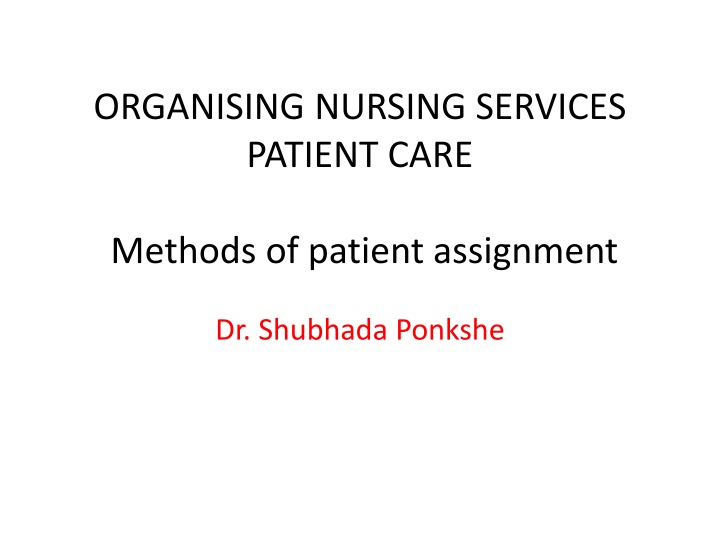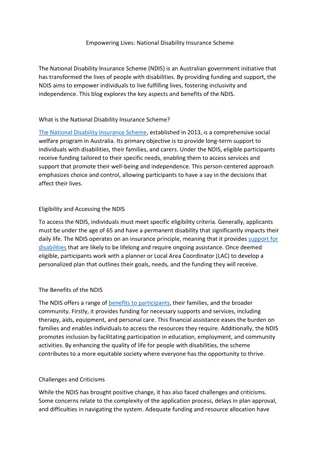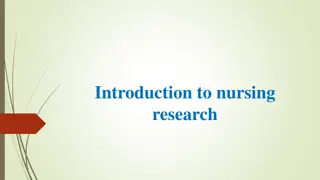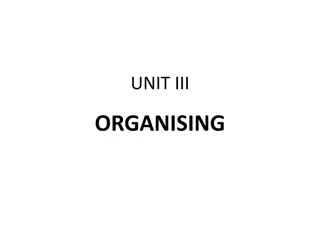Organising Nursing Services for Effective Patient Care
This content discusses methods of patient assignment, objectives of organising patient care units, factors influencing patient care quality, and considerations for organising patient care in wards. It emphasizes forecasting needs, professional activities, organizational activities, physical environment maintenance, training, and evaluation in patient care. The factors considered include administrative policies, patient needs, available personnel, nursing care methods, supervision, equipment, and morale.
Download Presentation

Please find below an Image/Link to download the presentation.
The content on the website is provided AS IS for your information and personal use only. It may not be sold, licensed, or shared on other websites without obtaining consent from the author.If you encounter any issues during the download, it is possible that the publisher has removed the file from their server.
You are allowed to download the files provided on this website for personal or commercial use, subject to the condition that they are used lawfully. All files are the property of their respective owners.
The content on the website is provided AS IS for your information and personal use only. It may not be sold, licensed, or shared on other websites without obtaining consent from the author.
E N D
Presentation Transcript
ORGANISING NURSING SERVICES PATIENT CARE Methods of patient assignment Dr. Shubhada Ponkshe
Line of talk enumerate the objective of organising the patient care unit; list the over-all goal of nursing care; describe the factors influence the quality of patient care; explain the factors to be considered while organising patients care in the wards; evaluate the nursing care given to patients; and discuss the factor influence the good ward management.
OBJECTIVES OF ORGANISING THE PATIENT CARE To forecast the needs and estimating the material and human resources required. List the activities to be performed according to areas of work which are as follows: Professional Activities: This embraces all activities necessary for rendering total patient care direct nursing care , dietary physiotherapy and pharmacy services etc. Organisational Activities: concerned with the management of the ward work and personnel involved. services, social work, These are activities
OBJECTIVES OF ORGANISING THE PATIENT CARE Physical Environment: Maintain the physical environment in patient care unit and guidance of professional staff responsible for cleanliness of the wards as a unit of the patient who have ultimate legal responsibility for safe and effective performance. Training: The education of personnel giving the nursing care and education of patient for positive health and distribution of staff. Evaluation: Evaluation of the patient care.
FACTORS TO BE CONSIDERED IN ORGANISING PATIENT CARE IN WARDS Administrative policies pertaining to patient care and to nursing service in a ward. Needs of patients Personnel available The total number of patient to be nursed The degree of illness of patients (physical dependency of patients) Type of service: medical, surgical, maternity, pediatric and psychiatric The total needs of patients
FACTORS TO BE CONSIDERED IN ORGANISING PATIENT CARE IN WARDS Methods of nursing care (patient assignment, functional and team) Number of nursing aids and other non professional available. The amount and quality of supervision available Hours of working The amount of, type and location of equipment and supplies such as central sterile supply etc. Knowledge of the duties to be performed Morale of workers Good ward management The physical facilities and design of wards Equipment and supplies needed
Process of organizing patient care Organising patient care is responsibility of Head nurse. 1. Planning 2. Assigning 3. Leading 4. Evaluating 5. Reporting
1. Planning: Is a process of developing a course of action for meeting the needs of patient. In planning, the head nurse decides what should be done, when, how, where, by whom and to whom. 2. Assigning: Assignment of patient and nursing activities are written in the assignment sheet by the head nurse/nurse in charge, based on the principles of assignment. Cont---
3. Leading: motivation, and coordination of activities, by making rounds, checking performance and conducting conferences. 4. Evaluating: By reviewing nursing performance and patient progress to be compared by the assignment and nursing care plan. 5. Reporting: The head nurse prepares a nursing unit report e.g. shift report which includes patient s needs, special observations, census, bed number, all critically ill and post operative patients, patients needs special preparation on the on-coming shift, patient s condition, data concerning admission, discharge, transfer and death. Includes issuing instructions, abnormal change in
Systems of Nursing Service Delivery Methods of patient care delivery The nursing manager has a responsibility of nursing care delivery demonstrate ways of organizing nursing s work. Within these advantages and disadvantages for quality of care, use of resources, and staff growth. systems that systems there are Cont---
Methods of patient care delivery Methods of patient assignment Case method or Total patient care Functional nursing Team nursing Modular or district nursing Progressive patient care Primary nursing Case management Cont---
Case Method Traced back to Florence Nightingale, began in the early days of the nursing profession. Individuals are assigned to give total care to each patient. In this method, nurses assume total responsibility for meeting all the needs of assigned patients during their time on duty, including the necessary medicine and treatments. It involves assignment of one or more clients to a nurse for a specific shift. Cont---
Case Method The patient has a different nurse each shift and no guarantee of having the same nurses the next day . This model is used in critical care areas, labor and delivery, or any area where one nurse cares for one patient s total needs. Here nurses were self-employed when the case method came into being, called as private duty nursing. Cont---
Case Method / Total Patient Care The nurses report to their immediate superior, who is the head nurse. Common use areas intensive care unit (ICU) and post anesthetic care unit (PACU) Cont---
Registered Nurse 8-hour shift Registered Nurse 8-hour shift Registered Nurse 8-hour shift Patient Care The registered nurse plans, organizes, and performs all care Total Patient Care (Case Method) Delivery
Case Method / Total Patient Care Advantages 1. High degree of autonomy 2. Lines of responsibility and accountability are clear 3. Patient receives holistic, un-fragmented care 4. Good client nurse interaction and rapport can be developed. 5. Client may feel more secure. 6. Work load can be equally divided by the staff. Disadvantages 1. Each RN may have a different approach to care 2. Not cost-effective 3. Lack of RN availability
Functional Method This system emerged in 1930s in U.S.A during WWII when there was a severe shortage of nurses in US. Assignments of patient care are made by the level of task; in other words, each person performs one task or functions in keeping with the employees educational experience. For example : Nurse Aides /Health Assistants/ give baths, feed patients, and take vital signs to all patients. Professional nurses are responsible for medications, treatments, and procedures for all patients. The head nurse is responsible for overall direction, supervision, and education of the nursing staff. Cont---
Nurse Manager LPN/LVN PO Meds Treatments RN Nurse Aide Vital signs Hygiene Nurse Aide Hygiene Stocking Assessments Care Plans Assigned Patient Group Functional Nursing Care Delivery Model
Functional Method 1. 2. Advantages Reduce personnel costs Each person become very efficient at specific tasks and a great amount of work can be done in a short time (time saving). It is easy to organize the work of the unit and staff. Nurses become highly competent with tasks that are repeatedly assigned to them. Less equipment is needed and what is available is usually better cared for when used only by a few personnel Disadvantages Fragments nursing care May decrease staff job satisfaction Decreases personal contacts with client Limits continuity of care 3. 4. 5. 1. 2. 3. 4.
Team Nursing Developed in 1950s because the functional method received criticism, a new system of nursing was devised to improve patient satisfaction. The team consists of the senior professional nurse becoming the team leader; the members of the team are other registered nurses (RNs), licensed practical nurses (LPNs) or vocational nurses, and nurses aides. Each is being given a patient assignment in keeping with the employee s education and experience.
Team Nursing This nurse leads the team usually of 4 to 6 members in the care of between 15 and 25 patients. The team leader make the assignments, delegated the work through the morning report, make rounds throughout the shift to make sure patients are being cared for properly, and conducts a team conference at the end of the shift to evaluate the patient care and plan an update nursing care plans.
Nurse Manager RN Team Leader RN LPNs/LVNs Nursing Assistants RN Team Leader RN LPNs/LVNs NursingAssistants Assigned Patient Group Assigned Patient Group Team Nursing Model
Team Nursing Advantages 1. High quality comprehensive care can be provided to the patient. 2. Each member of the team is able to participate in decision making and problem solving. 3. Each team member is able to contribute his or her own special expertise or skills in caring for the patient. 4. Improved patient satisfaction. 5. Work load can be balanced and shared. 6. There is a variety in the daily assignment. 7. Barriers between professional and non-professional workers can be minimized, the group efforts prevail. 8. May increases job satisfaction 9. Increases cost effectiveness
Team Nursing Disadvantages 1. Decreases personal contact with client 2. Limits continuity of care 3. Unstable staffing pattern make team nursing difficult. 4. The team leader may not have the leadership skills required to effectively direct the team and create a team spirit. 5. It is expensive because of the increased number of personnel needed. 6. Nurses are not always assigned to the same patients each day, which causes lack of continuity of care.
Primary Nursing By definition, primary nursing is a philosophy and structure that places accountability for the communicating and evaluating of care for a group of patients in the hands of the primary nurse. The primary nurse is expected to give total care, to establish therapeutic relationship, to plan for 24 hours continuity in nursing are through a written nursing care plan, to communicate directly with other members of the health team, land to plan for discharge. responsibility planning, and giving,
Primary Nursing If the nurse is not available, the associate nurse responsible for filling in for the nurse s absence will provide hospital care to the patient based on the original plan of care made by the nurse. In acute care the primary care nurse may be responsible for only intermediate care the primary care nurse may be responsible for three or more patients. one patient; in
Primary Nurse 24-hour responsibility for planning, directing & evaluating patient care Associate Nurses Provide care when primary nurse is off duty Physician and other members of the health care team Patient Primary Nursing Model
Advantages 1. May increase job satisfaction 2. Improves continuity of care 3. Allows independent decision making 4. Supports direct nurse-client communication 5. Encourages discharge planning 6. Improves quality of care Disadvantages 1. Increases personnel costs initially 2. Requires properly trained nurses to carry out systems principles 3. Restricts opportunity for evening and night shift nurses to participate. 4. Associate nurse may find it difficult to follow the plans made by another if there is disagreement or when patient s condition changes.
Progressive patient care It is a method in which client care areas provide various levels of care. Here the clients are evaluated with respect to all level (intensity) of care needed. Principal elements of PPC are: Intensive care or critical care: Patients who require close monitoring and intensive care round the clock, e.g. patients with acute MI, fatal dysarythmias. These units have 9-15 numbers of beds, life-saving equipment and skilled personnel for assessment, revival, restoration and maintenance of vital functions of acutely ill patients. Nursing approach in these units is patient-centered.
Progressive patient care Intermediate care: Critically ill patients are shifted to intermediate care units when their vital signs and general condition stabilizes, e.g. cardiac care ward, chest ward, renal ward. Convalescent and Self Care: Although rehabilitation programme begins from acute care setting, yet patients in these areas participate actively to achieve complete or partial self-care status. Patients are taught administration of drugs, life style modification, exercises, administration of insulin, checking pulse, blood glucose and dietary management. ambulation, self-
Progressive patient care Long-term care: Chronically ill, disabled and helpless patients are cared for in these units. Nurses and other therapists help the patients and family members in coping, ambulation, physical therapy, occupational therapy along with activities of daily living. Patients and family who need long-term care are, cancer patients, paralyzed and patients with ostomies.
Progressive patient care Home care: Some hospital/centers have home care services. A hospital based home care package provides staff, equipment and supplies for care of patient at home, e.g. paralyzed patients, post-operative, retarded/spastic patient and patient on long chemotherapy. Ambulatory care: Ambulatory patients visit hospital for follow up, diagnostic, curative rehabilitative and preventive services. These areas are outpatient departments, clinics, diagnostic centers, day care centers etc. mentally
Progressive patient care Advantages Efficient use is made of personnel and equipment. Clients are in the best place to receive the care they require. Use of nursing skills and expertise are maximized. Clients are moved towards self care, independence is fostered where indicated. Efficient use and placement of equipment is possible. Personnel have greater probability to function towards their fullest capacity.
Progressive patient care disadvantages There may be discomfort to clients who are moved often. Continuity care is difficult. Long term nurse/client relationships are difficult to arrange. Great emphasis is placed on comprehensive, written care plan. There is often times difficulty in meeting administrative need of the organization, staffing evaluation and accreditation.
Case Management American Nurses Association (ANA) has defined case management to be a system of health assessment, planning, service procurement and delivery, coordination, and monitoring to meet the multiple service needs of clients. Case management is a model of care delivery in which an RN case manager coordinates the patient's care throughout the course of an illness.
Case Management The case manager (RN or social worker with managerial qualification) responsibility of following a patient s care and progress from the diagnostic phase through hospitalization, rehabilitation and back to home care. For eg; case manager for cardiac surgery patients assists them go through diagnostic procedures, pre-operative preparations, surgical interventions, family counseling, post-operative care and rehabilitation. is assigned
Collaborates With Patient and Family NURSE CASE MANAGER Assesses, plans, implements, coordinates, monitors, and evaluates patient care options and services to meet health needs Onset of Illness Resolution of Illness Collaborates with Nursing, Physicians, Physical/Speech/ Occupational Therapists, Dietary, and Ancillary Services Coordinates Services: Home Care, Hospice, Extended /Long-term Care Ambulatory Care Services Nursing Case Management Model
Components of Case Management Assessment. Review the client's history and current status Perform comprehensive health assessment Identify available resources and support system (e.g., individual, family, financial, health insurance, community) Identify barriers to accessing necessary treatment (e.g., lack of health insurance coverage; no family support)
Components of Case Management Assessment. Identify health promotion and disease prevention opportunities Identify adherence patterns, educational needs, and ability to learn Determine potential for overuse or under use of resources Find, appraise, and use research findings as the basis for treatment decisions (evidence-based practice)
Components of Case Management Planning. Prioritize needs and set realistic, measurable goals and outcomes Identify realistic treatment options Coordinate various providers involved in the plan of care (e.g., physician, physical therapist, dietitian) Determine appropriate levels of care and realistic treatment settings (e.g., home, long-term care, rehabilitation facility) Identify and address gaps in care Ensure continuity of care Negotiate and manage financial aspects of care
Components of Case Management Implementation Ensure implementation of the care plan in a safe, timely and cost-effective manner Coordinate services and referrals to providers or agencies Ensure compliance with federal, state, and local regulations and standards Use appropriate community resources Document progress toward achieving goals and outcomes Accept accountability for implementation of the care plan
Components of Case Management Evaluation Measure clinical goals, functional improvement, satisfaction with services and cost-benefit of treatment plan Is/was the plan of care realistic, collaborative, and mutually beneficial to all involved? Are/were the established time frames realistic? Are/were the best possible and most cost- effective treatments used? Are/were individual educational opportunities maximized?
Components of Case Management Interaction Interact on a daily basis with diverse groups of people: client, family members, and significant others; health care team members; payer representatives; representatives from other health care agencies and community organizations Motivate diverse groups to cooperate, collaborate, and work in the best interest of the client Use good communication, negotiation, facilitation, and documentation skills.
Advantage 1. Improves nurse responsiveness to clients 2. changing needs 3. Improves continuity of care 4. May increase nurse s job satisfaction Disadvantage 1. Increases personnel costs























